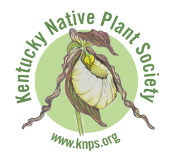By David Taylor
On November 4, several brave hikers joined me for the Not Quite Winter Botany field trip at the Berea College Forest (Berea Woods). The day’s start was a bit chilly while waiting for everyone to arrive. Once we began to hike, we warmed and the air temperature did as well.

We hiked through oak forest on acids soils developed over Devonian shale, then into mixed mesophytic forest on basic soils developed over Mississippian limestone and compared forest composition. A total of about 30 woody plants — vines, shrubs and trees — were seen with about the same number of herbaceous plants, mostly forbs and some grasses.
The previous week, the area experienced temperatures below 20 for two nights in a row and several other nights around 30. We anticipated finding many plants without leaves. That was not the case. Most shrubs and trees still held leaves, as did many of the herbaceous plants. We had trouble finding fruits of plants and our trip focused on bark and leaves. Some herbaceous plants were still in flower. For example, late purple aster (Symphyotrichum patens) and others such as small-disk sunflower (Helianthus microcephalus) still had identifying remnants of inflorescences.
There was ample opportunity, unfortunately, to discuss nonnative invasive species. The trail corridor provided habitat for a number of them. Many questions were asked and we spent more time having discussions or looking for examples of specific characters than hiking.
We did not reach our goal of Indian Fort Lookout before we had to turn around due to time limitations and identification based on fruit was limited. The trip was a success just the same. Participants were able to see a variety of species, including some nonnative invasive species in winter conditions to aid identification in other places. We had good discussion and laughs and a few people will be coming back to the area in the spring to check out the wildflowers.
David has been interested in plants since elementary school. During middle and high school years, he began a list of the plants found in the fields and forest near his home. He also began to grow wildflowers in a garden that his mother soon adopted. At Berea College, he was exposed to formal botany classes and began to collect extensively (with permission) in the Berea College Forest, updating a much earlier collection. In graduate school, he completed a preliminary flora of St. Tammany and Washington Parishes, Louisiana. After teaching at Cumberland College for two years, he joined the U.S. Forest Service as Forest Botanist for the Daniel Boone National Forest. He has been in that position for more than 30 years working primarily with rare plants and nonnative invasive plants.
David has worked with the Kentucky Native Plant society for about 30 years, serving mostly as grants chairperson. He has contributed about a dozen articles to The Lady Slipper over the years. David lives outside of Berea, where he grows a variety of plants and works to remove invasive species from grown up pasture land.
